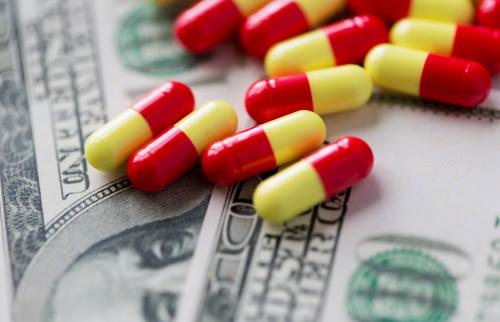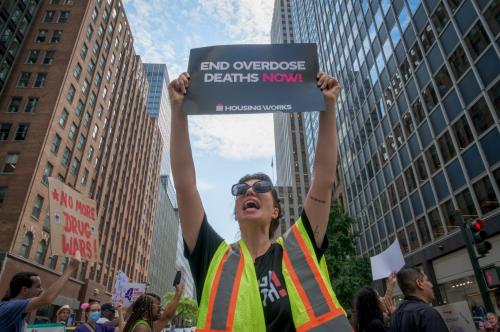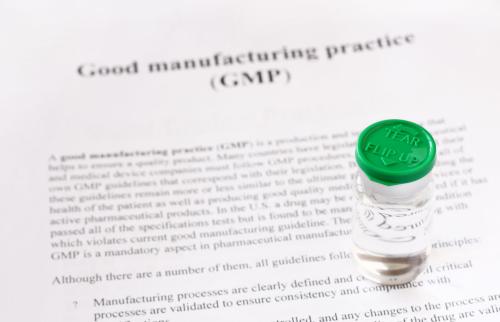One tool federal policymakers have used to lower drug prices is the imposition of inflation rebates, which require drug companies to pay rebates when the list price of a product increases faster than the rate of inflation. Under current law, inflation rebates apply in many market segments, but not to units of a drug sold to patients with commercial insurance. This piece explores how state policymakers could fill this gap—in ways that are insulated from manufacturer challenges under the Commerce Clause of the Constitution and from federal restrictions that limit when states can raise revenue from health care providers.
Inflation rebate requirements as a tool to lower drug prices
To combat the high price of prescription drugs, federal law includes a number of policies that require drug manufacturers to make payments to the federal government when the price of their medications increase faster than the rate of inflation. Since the early 1990s, manufacturers of prescription drugs have been required to pay inflation-based rebates to state Medicaid agencies and to provide larger discounts under the 340B program when the list price of covered drugs increases faster than inflation. In 2022, Congress extended a more narrowly targeted inflation rebate to Medicare, requiring inflation rebate payments to the federal government for single source drugs without generic competition where per-patient costs are greater than $100 per year.
When Congress enacted the 2022 expansion, it initially attempted to apply the new inflation rebate outside of Medicare as well, to drugs sold to patients with commercial insurance (like health insurance through a job or in the individual market). However, the Senate parliamentarian concluded that the expansion to commercial insurance was subject to challenge under the rules of budget reconciliation, so the provision was removed from the bill. Therefore, today, when a brand-name drug company raises prices faster than inflation, it must make additional payments in Medicare, Medicaid, and 340B that effectively claw back any price increase higher than the rate of inflation. However, for commercially insured patients not served by a 340B provider, the drug manufacturer can retain the extra price increase without penalty.1
States have an opportunity to fill this gap. A state could impose its own inflation rebate requirement to require payments to the state for units of a drug sold to commercially insured patients in the state. The most straightforward policy would use the same approach as the 2022 federal statute—limiting the rebate requirement to brand-name drugs costing more than $100—to avoid invoking concerns that an inflation rebate for low-cost generic drugs can exacerbate the risk of drug shortages. Such a policy would achieve some mix of raising revenue for the state and deterring price increases from occurring in the first place: inflation rebates applicable in only a handful of jurisdictions would largely raise revenue, but as the scope of commercial sales subject to rebates expands, then these price increases are less likely to occur. States wishing to pursue an inflation rebate must, however, be mindful of considerations arising from the Constitution and from federal statute that will constrain how they design a program, as described below.
The dormant Commerce Clause and state drug pricing efforts
One limit on state efforts to regulate pharmaceutical prices is the dormant Commerce Clause of the Constitution: because the Constitution confers to Congress the authority to regulate interstate commerce, courts have long held that state laws that interfere with interstate commerce can be unconstitutional. Courts have struck down laws that attempt to privilege in-state economic activity over out-of-state goods, as well as laws that are not expressly protectionist but nonetheless impose a burden on interstate commerce that is impermissibly large.
Current dormant Commerce Clause jurisprudence is not characterized by well-defined doctrine. In 2023, the Supreme Court forcefully rejected an attempt to create an “almost per se” prohibition on state laws that affect economic activity outside the state (also called an “extraterritoriality” principle), but a set of concurrences and dissents failed to establish controlling precedent for a clear set of rules. The opinion of the Court did, however, reiterate that it is not permissible to “tie[] the price of in-state products to out-of-state prices” and that state laws that have the effect of regulating out-of-state prices can be problematic, and a majority of Justices seemed to endorse the general argument that state laws tied to out-of-state impacts can raise concerns.
When policymakers attempt to regulate drug prices, they often look to national data sources that compile information on commercial transactions across the country to determine what the price of a drug actually is. This includes the nationwide Wholesale Acquisition Cost (WAC), Average Manufacturer Price (AMP), or Average Sales Price (ASP) metrics, which are calculated based on mandatory reporting to the federal government. Because of the nature of the drug supply chain—where drug manufacturers sell their products to national wholesalers, who then resell them to individual pharmacies—these prices are reasonably accurate measures of the cost of products at a given point in the supply chain. However, state use of these data sources, which necessarily involve information about prices outside the state, has been the basis of dormant Commerce Clause challenges.
The pharmaceutical industry has argued—often successfully—that when states regulate conduct or impose penalties based on the prices at which drugs move through the national supply chain (i.e., the prices that appear in the national pricing metrics), they are impermissibly regulating economic conduct occurring outside the state. The industry claims that state law consequences are impermissibly being imposed based on the outcome of a commercial transaction (e.g., the sale of drugs from manufacturer to wholesaler) that occurred entirely outside the state. For example, the Eighth Circuit recently struck down a Minnesota price gouging law based on WAC because when the state penalized manufacturers based on certain changes in WAC, it was necessarily “t[ying] the price of in-state products—prescription drugs—to the price that out-of-state manufacturers charge their wholesalers.” The Fourth Circuit struck down a similar Maryland law for similar reasons in 2018. Conversely, a district court in Illinois recently rejected a challenge to a price gouging law based on WAC, and argued that a state law does not violate the dormant Commerce Clause just because it looks to the prices charged in out-of-state transactions. And in 2003, the Supreme Court upheld a Maine law that imposed process burdens in Medicaid if drug manufacturers did not enter into rebate agreements in part based on national pricing measures, because the state did “not insist that manufacturers sell their drugs to a wholesaler for a certain price”—though in doing so the Court also conveyed that such “insistence” could be problematic.
The dormant Commerce Clause also limits the ways in which states can impose taxes. The Supreme Court has articulated a four-part test, examining the extent to which the tax: “(1) is applied to an activity with a substantial nexus with the taxing state; (2) is fairly apportioned; (3) does not discriminate against interstate commerce; and (4) is fairly related to the services provided by the state.” Congress has also regulated the way in which states impose taxes on corporate income in particular, and most states impose some corporate income tax; large pharmaceutical manufacturers are generally subject to these taxes but may in practice pay little or nothing in tax.
Designing a state inflation rebate requirement to avoid dormant Commerce Clause challenges
Reviewing this history, it is risky for a state to attempt to construct an inflation rebate based on increases in a national pricing metric like WAC, AMP, or ASP (though, as noted above, some courts have allowed such linkages). Still, a state law will be less susceptible to a dormant Commerce Clause challenge if a state can trigger its inflation rebate based on a state-specific metric of price increases. While not all states have ready access to such data, in many states, this information is available to state policymakers.
Specifically, nearly half of states have established state-level All-Payer Claims Databases (APCDs), where commercial (and other) payers in the state report information about paid health care claims. These data are based on in-state commercial transactions, i.e., payments to an in-state health care provider from any health care payer. With respect to outpatient drugs, claims data will generally illustrate ingredient costs and dispensing fees for each paid claim. For physician-administered drugs, details will depend on the state, but the APCD will generally also separately identify payment associated with the drug, separate from other services. These data are not exactly the same as AMP and ASP (the basis for federal inflation rebates), but they will generally move in the same direction at roughly the same speed. Therefore, a state with robust reporting to an APCD can establish a state-law inflation rebate based on changes in ingredient costs for prescription drugs in APCD claims data. It can also use the APCD to count the units of the drug paid by commercial insurance to which the rebate requirement should apply.2 States also have options to make a state-law inflation rebate more or less aggressive by selecting a base year against which changes will be measured: looking further in the past will result in a more powerful state inflation rebate. If APCD data are incomplete or otherwise not available, states can also consider basing an inflation rebate on other sources of claims data—like the claims paid by the state employee health plan or data provided by vendors that look specifically at claims paid in a specific state (rather than nationwide transactions).
Pharmaceutical companies may attempt to argue that, despite the reliance on in-state data, such a structure continues to violate the dormant Commerce Clause because the out-of-state transactions between manufacturers and wholesalers feed into the price pharmacies charge payers for the drug. That is, if the manufacturer wishes to reduce the price pharmacies in state X are paid when a drug is dispensed, they will have to reduce the price the manufacturer charges the wholesaler in a transaction occurring in state Y. Similarly, manufacturers may argue that they do not control the price at which claims are paid in state X, or that exerting more control would require them to change the terms of the manufacturer-wholesaler transactions in state Y. But these arguments are the sort of challenge that the Supreme Court rejected in 2023, where it disavowed any “per se” prohibition based only on a state law’s “practical effect” on out-of-state economic activity. Therefore, these claims are less likely to pose a serious threat to state law.
States will also need to attend to the Court’s general rules on the imposition of taxes. A detailed discussion of that jurisprudence is beyond the scope of this analysis, but in general, states have plausible ways to design an inflation rebate requirement consistent with applicable precedent. In particular, the in-state nature of the regulated economic activity and arrangements between state Medicaid programs and pharmaceutical manufacturers can be the basis for establishing nexus, and a design that counts actual units of sales that are not subject to federal inflation rebates will be useful to ensure fair apportionment.
In sum, many observers have concluded that while the dormant Commerce Clause does constrain state law, states have options for action as long as they focus on the actions of in-state actors and avoid imposing state law consequences based on the price associated with transactions (e.g., between manufacturers and wholesalers) that occur outside the state. The approach to a state inflation rebate described here would fit well within those contours.
Provider taxes and the pharmaceutical industry
A state inflation rebate along the lines discussed above is likely to achieve some combination of deterring list price increases by manufacturers and raising revenue. To the extent a state receives revenue from health care-related activities, it must be mindful of restrictions in the federal Medicaid program on “health care-related taxes”—restrictions which have been tightened significantly in recent federal legislation. Fortunately, it is feasible to design an inflation rebate in ways that do not risk running afoul of federal law. To understand how, it is useful to trace the somewhat convoluted history of federal legislation and regulation in this area.
Prior to the early 1990s, there were no federal limits on state receipt of revenue from providers. However, in response to growing state use of provider-specific taxes and “donations” from health care providers, and about whether these mechanisms were appropriate, in 1991, Congress enacted legislation limiting the use of provider taxes and donations.3 As a threshold matter, provider taxes would only be allowed if they were “broad-based,” meaning that they generally applied uniformly to a type of provider.4 However, even a “broad-based” health care tax would be impermissible if it included a “hold harmless provision” that took steps—either “directly or indirectly”—to “guarantee” that providers received more Medicaid payments back than they received in taxes.5 If a state received any revenue that constituted an impermissible provider tax, regardless of how the state purported to use that revenue, federal Medicaid payments would be reduced.
After this legislation was enacted, the Centers for Medicare and Medicaid Services (CMS, then called the Health Care Financing Agency) promulgated regulations that attempted to define the types of circumstances where an impermissible “hold harmless” would be found to exist. In 1992 rules, CMS explained that it would prohibit a variety of structures that expressly linked tax and Medicaid payments. The agency also created a new, two prong “guarantee” test that would determine if a tax included an impermissible indirect hold harmless. The guarantee test was intended to define circumstances where, even though there was no express provision of law that held a taxpayer harmless, the tax paid and Medicaid payments received were of sufficient magnitude that federal law should treat the tax as “indirectly” constituting a hold harmless. The guarantee test persists largely in its original form, and current regulations provide:
(A) An indirect guarantee will be determined to exist under a two prong “guarantee” test. If the health care-related tax or taxes on each health care class are applied at a rate that produces revenues less than or equal to 6 percent of the revenues received by the taxpayer, the tax or taxes are permissible under this test. The phrase “revenues received by the taxpayer” refers to the net patient revenue attributable to the assessed permissible class of health care items or services….
(B) When the tax or taxes produce revenues in excess of the applicable percentage of the revenue received by the taxpayer, CMS will consider an indirect hold harmless provision to exist if 75 percent or more of the taxpayers in the class receive 75 percent or more of their total tax costs back in enhanced Medicaid payments or other State payments. The second prong of the indirect hold harmless test is applied in the aggregate to all health care taxes applied to each class.
That is, a tax will be impermissible if (a) the tax paid is more than 6% of the net patient revenue received by the health care provider, and (b) the class of taxpayers (e.g., hospitals) generally receives sufficient Medicaid payments such that most taxpayers (at least 75%) receive “enhanced Medicaid payments or other State payments” that offset most (at least 75%) of their tax burden.6
In 2006, Congress returned to this arena. Specifically, Congress effectively codified the “guarantee test” into the statutory definition of a hold harmless provision, saying that “the existence of indirect guarantee” shall be made “under” the regulations defining the two prong guarantee test.7 This statutory language referred to the full, two prong test, and it directed CMS to use a lower numerical threshold in the first part of the test from 2008 to 2011.
In 2025, Congress sought to further limit state use of provider taxes. It did so by again lowering the percentage of revenue that will constitute a violation of the first prong of the regulatory guarantee test—to 0% if a state did not impose a tax on that class of providers as of the date of enactment, and, for existing provider taxes, to thresholds phasing down to 3.5% for states that have expanded Medicaid under the Affordable Care Act.8 The 2025 legislation made no structural changes, continuing the 2006 approach of codifying the use of both prongs of the regulatory guarantee test.
Now, consider how this language would apply to a state wishing to raise revenue from pharmaceutical manufacturers. Such sources of revenue could be considered a health care-related tax that is subject to the requirement that it be broad-based and not include an impermissible hold harmless. The phrase “health care-related tax” is defined broadly to include “any licensing fee, assessment, or other mandatory payment,” “imposed with respect to a class of health care items or services,” inclusive of “outpatient prescription drugs.”9
In addition, to the extent that the state does not raise revenue from pharmaceutical manufacturers today, the applicable percentage under the first prong of the guarantee test would be 0%. However, because of the structure of Medicaid payments for prescription drugs, it would still be quite unlikely that an inflation rebate payment (or any other revenue collected from pharmaceutical manufacturers) could actually violate the guarantee test. Specifically, state Medicaid programs generally do not make payments to manufacturers of prescription drugs: instead, payments are received by pharmacies and health care providers, who have acquired the drug product from wholesalers. Put another way, while pharmaceutical manufacturers certainly earn revenue when their drugs are dispensed to Medicaid patients, they do not themselves receive any Medicaid payments. Therefore, in assessing the second prong of the test—has the “taxpayer” received at least 75% of “their total tax costs back in enhanced Medicaid payments”—the state approach will generally be permissible under the guarantee test, because the pharmaceutical manufacturer taxpayer is receiving none of its tax costs back in Medicaid payments at all. That is, revenue raised from pharmaceutical manufacturers will generally always be allowable under the second prong of the guarantee test,10 and therefore be permissible (absent some other statutory problem).
In sum, as long as the incidence of any inflation rebate requirement is on pharmaceutical manufacturers—not pharmacies or other entities that receive Medicaid payments—the state policy should not be considered an impermissible provider tax. Indeed, as some states consider changes to their Medicaid funding structure in the wake of new federal limits, an inflation rebate requirement could be particularly attractive.
Conclusion
Inflation rebates are a longstanding tool to lower drug prices and raise revenue. In 2022, Congress nearly enacted an inflation rebate that would apply to sales of drugs for patients with commercial insurance, but was blocked from doing so by Senate rules—a fact which has no impact on the policy merits of a broad inflation rebate. Therefore, states can step in and fill the gap through a state-based rebate requirement. To help avoid constitutional challenges, states should base their rebate on state data from a state All–Payer Claims Database or other source of claims data, and as long as payments must be made by pharmaceutical manufacturers, the structure should not be considered an impermissible provider tax in Medicaid.
-
Acknowledgements and disclosures
The author thanks Richard Frank, Katie Keith, and Andrew Twinamatsiko for helpful comments, Sam Peterson and Vani Agarwal for superb research assistance, and Rasa Siniakovas for editorial and web posting assistance. All errors are our own. This work was supported by a grant from Arnold Ventures. At the time of posting, the author was a pending nominee for a senior role in state government; this post is unrelated to her nomination and the responsibilities associated with that role. The content here reflects her personal views.
-
Footnotes
- For rebates paid in Medicare on Part B covered drugs, the amount of the rebate paid in Medicare is based on the net price paid by all purchasers, which means manufacturers do face some incentive to keep prices lower in the commercial segment of the market in order to influence rebates paid.
- It will generally not be possible to identify 340B-related claims in an APCD. States may wish to include a uniform reduction in units based on the average rate of 340B claims to address this issue.
- The Bush Administration had issued rules that would have prohibited the use of provider taxes entirely, and Congress ultimately enacted the more nuanced limits described here.
- 42 U.S.C. 1396b(w)(1)(A)(ii) and (3)(B).
- 42 U.S.C. 1396b(w)(1)(A)(iii) and (4).
- 42 CFR 433.68(f)(3)(i).
- 42 U.S.C. 1396b(w)(4)(C)(ii).
- 42 U.S.C. 1396(b)(w)(4)(D).
- The statute excludes “a criminal or civil fine or penalty” from the definition of tax, and it may be possible for a state to design an inflation rebate in ways that would be treated as a civil fine.
- Note that the first and second prong of the guarantee use different language to refer to dollars received by the taxpayer. The second prong looks to “enhanced Medicaid payments or other state payments,” a phrase which is fairly unambiguous in describing dollars paid by the state to the taxpayer. Conversely, the denominator in the first prong of the test is “net patient revenue.” One might attempt to argue that pharmaceutical manufacturers also don’t receive net patient revenue, but little would turn on that issue.
The Brookings Institution is committed to quality, independence, and impact.
We are supported by a diverse array of funders. In line with our values and policies, each Brookings publication represents the sole views of its author(s).






